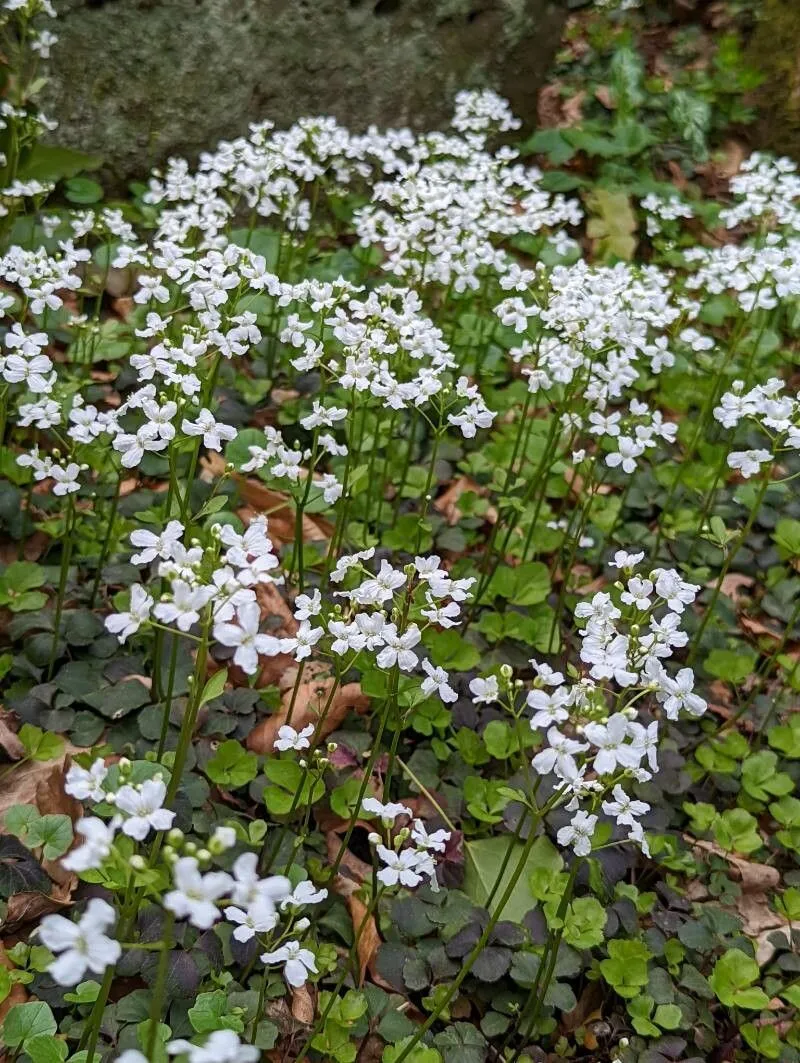
Author: L.
Bibliography: Sp. Pl.: 654 (1753)
Year: 1753
Status: accepted
Rank: species
Genus: Cardamine
Vegetable: False
Observations: C. Europe to Serbia
Three-leaved bittercress, scientifically known as Cardamine trifolia, is a fascinating plant that belongs to the Brassicaceae family. First described by the renowned botanist Carl Linnaeus in his seminal work “Species Plantarum” in 1753, this plant is native to Central Europe and extends its range to Serbia.
Cardamine trifolia thrives in moist, shaded environments, often gracing the understory of deciduous woodlands. Its distinctive trifoliate leaves, arranged in sets of three, make it easily identifiable and contribute to its common name. Each leaflet is dark green and finely serrated, creating a delicate yet resilient appearance. This perennial herb typically blooms in the early spring, producing clusters of small, white flowers that add a subtle beauty to the forest floor.
Beyond its aesthetic appeal, the three-leaved bittercress plays a crucial ecological role. It serves as a food source for various insect species and contributes to the biodiversity of its native habitat. Gardeners and botanists appreciate its low-maintenance nature and its ability to spread and naturalize in suitable environments.
In summary, Cardamine trifolia is a plant of both historical and ecological significance, embodying the rich botanical heritage of Central Europe and Serbia. Its presence in wooded landscapes brings both beauty and ecological benefits, making it a plant worthy of admiration and study.
Deu: kleeblättriges schaumkraut
Eng: trefoil cress
Cym: berwr chwerw tribys, berwr tribys
En: Three-Leaved Bittercress, Trefoil Cress, Trifoliate Bittercress
Fi: Kolmilehtilitukka
Fr: Cardamine à trois folioles
De: Dreiblättrige Zahnwurz, Dreiblatt-Schaumkraut, Kleeblättriges Schaumkraut, Kleeblatt-Schaumkraut, Kleeschaumkraut, Dreiblättriges Schaumkraut
It: Billeri a tre foglie
Cy: Berwr Chwerw Tribys, Berwr Tribys
Taken May 12, 2022 by Kerstin Mossed (cc-by-sa)
Taken Apr 26, 2022 by Jona Lumo (cc-by-sa)
Taken Apr 19, 2022 by manuseitz (cc-by-sa)
Taken Sep 8, 2021 by Simon Brumby (cc-by-sa)
Taken Apr 29, 2022 by Jani Zadrgal (cc-by-sa)
Taken Apr 26, 2022 by Jona Lumo (cc-by-sa)
Taken Apr 19, 2022 by manuseitz (cc-by-sa)
Taken May 10, 2021 by Irmgard Hemetsberger (cc-by-sa)
Taken Apr 29, 2022 by Jani Zadrgal (cc-by-sa)
Taken Apr 29, 2022 by Jani Zadrgal (cc-by-sa)
Taken Jan 1, 1970 by Photoflora – L’Abbé COSTE (©)
Taken Jul 15, 2019 by Photoflora – Benoit BOCK (©)
Taken Apr 19, 2022 by manuseitz (cc-by-sa)
Taken Mar 28, 2021 by Sergio costantini (cc-by-sa)
Taken Apr 19, 2022 by manuseitz (cc-by-sa)
Taken Apr 18, 2022 by Jani Zadrgal (cc-by-sa)
Taken Apr 19, 2022 by manuseitz (cc-by-sa)
Taken May 10, 2021 by Irmgard Hemetsberger (cc-by-sa)
Ph maximum: 8.0
Ph minimum: 7.5
Light: 3
Atmospheric humidity: 6
Bloom months: [‘apr’, ‘may’, ‘jun’]
Soil nutriments: 7
Family: Myrtaceae Author: (F.Muell.) K.D.Hill & L.A.S.Johnson Bibliography: Telopea 6: 402 (1995) Year: 1995 Status:…
Family: Rubiaceae Author: Pierre ex A.Froehner Bibliography: Notizbl. Bot. Gart. Berlin-Dahlem 1: 237 (1897) Year:…
Family: Sapindaceae Author: Koidz. Bibliography: J. Coll. Sci. Imp. Univ. Tokyo 32(1): 38 (1911) Year:…
Family: Asteraceae Author: A.Gray Bibliography: Pacif. Railr. Rep.: 107 (1857) Year: 1857 Status: accepted Rank:…
Family: Fabaceae Author: Medik. Bibliography: Vorles. Churpfälz. Phys.-Ökon. Ges. 2: 398 (1787) Year: 1787 Status:…
Family: Aspleniaceae Author: (Cav.) Alston Bibliography: Bull. Misc. Inform. Kew 1932: 309 (1932) Year: 1932…